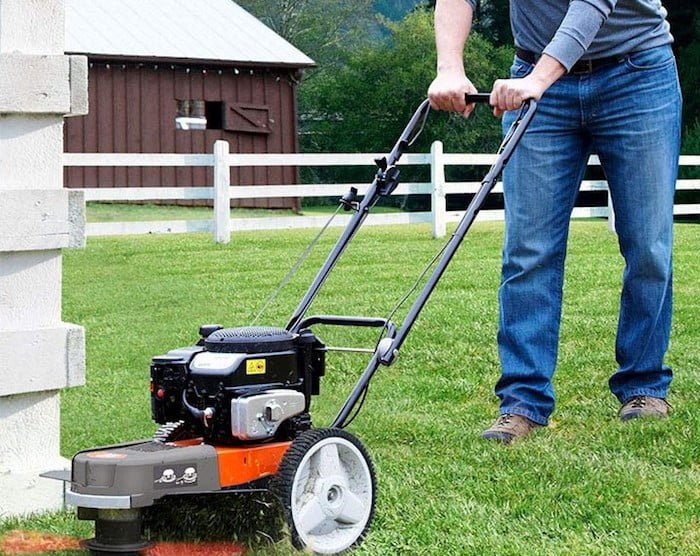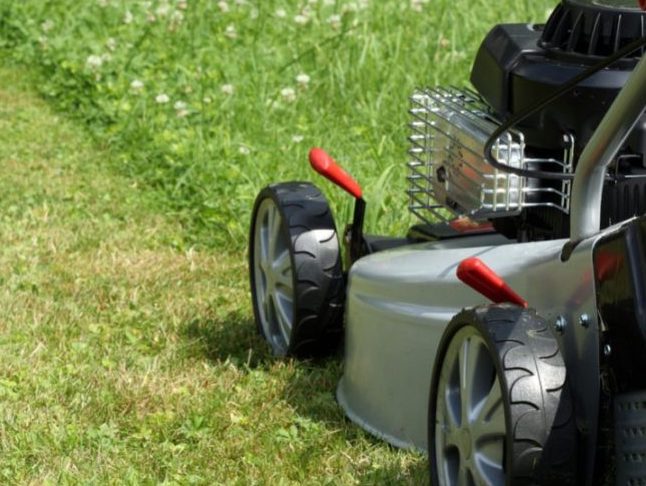

Walk-Behind
Weeds are a perennial problem in every yard and garden. There are so many different varieties it is hard to keep up with the rate at which they grow.
If you have a larger space, you may find it tiring to go over the whole area with your regular weed eater. That’s no surprise as, while they are great machines, they do need some handling. What’s the alternative? The Walk Behind String Trimmer!
This is, in pretty much every way, a bigger version of the weed eater, one that doesn’t need carrying. They come in various designs and sizes, and from a range of top brands. Some are merely trimmers, others double as lawnmowers, and generally, you push them along as they cut.
You will also find them with a number of different engine options: gas-powered walk-behind string trimmers are the powerful option and come in both 2-stroke and 4-stroke models – more about that below – while electric models are also available, and we’ll talk about the benefits of each as you read on.
Which is for you? That depends on a number of factors, so as well as this article, we recommend you check out this detailed review of some of the best models at TraditionalGardening as it covers the options in dome depth. Let’s start by looking at the differences in the various power options.
Which Type Do You Need?
So, of the different types of powerplant used in walk behind string trimmers, which is best for your needs? That depends entirely on how large your yard is, how virulent your weeds are, and how often you are going to be using the machine. Here are the two main types, and the benefits of each:
Gas Powered Trimmer – powered by either a 2-cycle or 4-cycle gas engine, this is the most powerful type of walk behind trimmer, and these are popular with people with large yards, and also with commercial users. The advantage over electric is they are very powerful, usually have a larger cutting area, and are not restricted by a power cord or battery life. The disadvantage is they are heavier to handle, need more maintenance, and require fuel to get them going. They can also be harder to start in some cases.
Briefly, a 2-cycle engine is a more basic design than a 4-cycle model – which is more like that you will find in your car. 2-cycle engines need a mixture of gas and oil but are very powerful, 4-cycle just uses gas and is more efficient, plus the latter produces far less in the way of pollution.
Electric Walk-Behind Trimmer – for smaller and medium-sized yards, the electric trimmer may be the route to take. The convenience of these models lies in the fact you just plug in, switch on and go – or in the case of battery-powered designs; you charge up, switch on and go – rather than having to prime the engine and go through the motions to get it started.
They are also lighter and easier to handle. The negatives are they usually have a smaller cutting swathe, and they are restricted by the power cable or battery life, plus they are not as powerful as gas models.
So, now you know the difference, we can talk more about what the walk behind trimmer can do for you, and why you need one.
The Benefits of the Walk Behind String Trimmer
The benefits of a walk-behind trimmer over a standard model are many. As we mentioned earlier, the walk-behind design does not require you to pick it up and handle it; it is designed like a mower to be wheeled along and comes with an adjustable handle so you can find your preferred and most comfortable position for operating it.
Added benefits are that a walk-behind trimmer will likely have a larger cutting swathe than other models, so you get more weeds removed in one go, and you can cover a greater area in a shorter time.
The problem with choosing a walk behind string trimmer is that this is a competitive market, which is why we’re here to help! Below is a brief summary of the factors you need to consider when you are looking at such a machine.

String-Trimmer
What to Look for in a Walk Behind String Trimmer
We’ve put together some of the features to consider when choosing your walk behind string trimmer, so let’s not hang about!
Power Source – well be brief here as we’ve talked about the difference between electric and gas-powered models, so will simply say that if you have a bigger than average space to deal with, you should certainly consider a gas model.
Cutting Swathe – this is the width of the path the string will cut, and generally, the wider, the better! You will usually find that electric models have a smaller cut width – often around 12-inches – while the gas-powered models cut wider. This can be anything from 17 to 22-inches, which is quite a large difference.
Ease of Use – an electric model you just switch on, but with a gas model, you need to ask if it has an easy-start system. Also, check how easy it is to change the string – sometimes it can be frustratingly complex – and that you can buy string ready wound to simply slot into place as is the way with more up to date models.
Wheel Size – this is an important factor that you may not think of at first. Some models feature huge, over-sized wheels, and this is for a good reason. Smaller wheels make things more difficult on rough terrain or anything other than a smooth surface, and bigger wheels make it a lot easier!
That’s a few of the major features to look for – you will also need to set a budget as the prices can vary somewhat – and we hope that we’ve helped you see why a walk behind string trimmer is an essential item for larger gardens.
